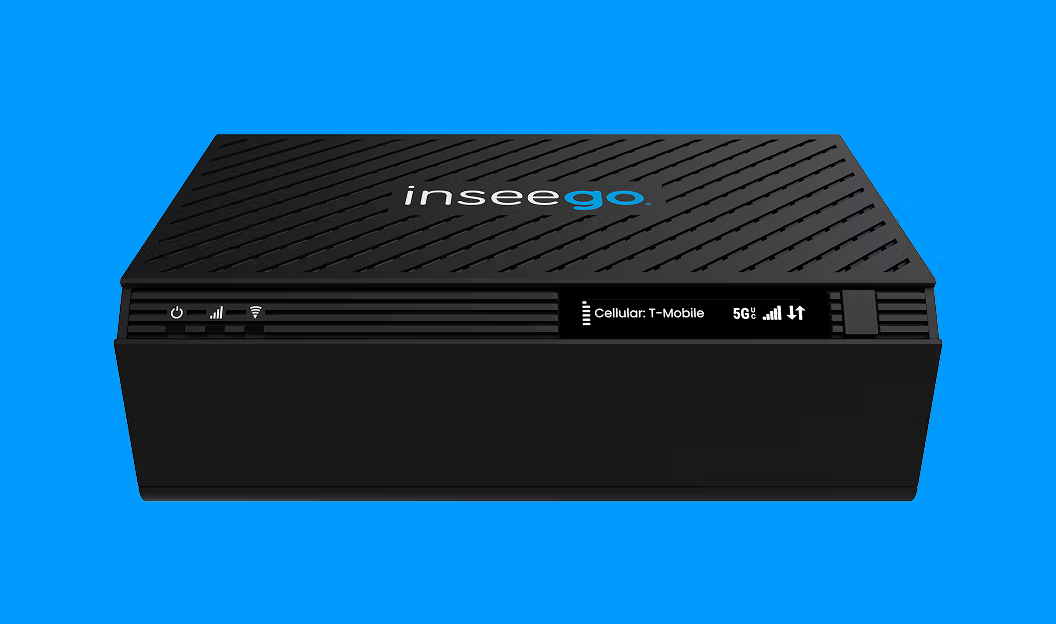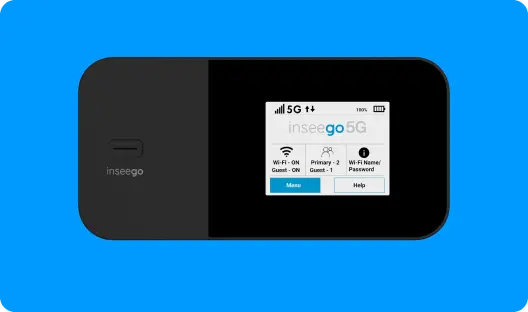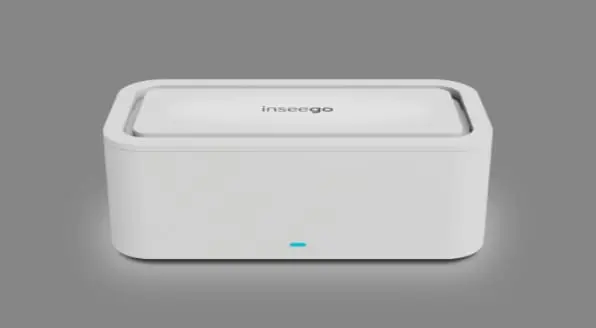User guide
- Product documentation
- Inseego MiFi® X PRO
- User guide
Glossary
4G LTE — Fourth Generation Long Term Evolution. LTE is a standard for wireless data communications technology and an evolution of the GSM/UMTS standards. The goal of LTE is to increase the capacity and speed of wireless data networks using new DSP (digital signal processing) techniques and modulations that were developed around the turn of the millennium. A further goal is the redesign and simplification of the network architecture to an IP-based system with significantly reduced transfer latency compared to the 3G architecture. The LTE wireless interface is incompatible with 2G and 3G networks, so that it must be operated on a separate wireless spectrum.
5G — Fifth Generation. The successor to 4G LTE technology, offering greater bandwidth and higher download speeds. In addition to serving cellular networks, 5G networks can be used as internet service providers, competing with other ISPs. 5G also opens up new IoT and M2M possibilities. Wireless devices must be 5G enabled to use 5G networks.
802.11 (a, b, g, n, ax) — A set of WLAN Wi-Fi communication standards in the 2.4 and 5 GHz frequency bands.
APN — Access Point Name. The name of a gateway between a mobile network and another computer network, often the internet.
bps — Bits per second. The rate of data flow.
Broadband — High-capacity high-speed transmission channel with a wider bandwidth than conventional modem lines. Broadband channels can carry video, voice, and data simultaneously.
DHCP — Dynamic Host Configuration Protocol. Software found in servers and routers that automatically assigns IP addresses and other configuration data to computers, tablets, printers, and other devices connection to the IP network.
DHCP Server — A server or service with a server that assigns IP addresses.
DMZ — demilitarized zone. A sub-network that contains and exposes an organization's external-facing services to an untrusted network, usually a larger network such as the internet.
DNS — Domain Name System. A system for converting host names and domain names into IP addresses on the internet or on local networks that use the TCP/IP protocol.
ECGI — E-UTRAN Cell Global Identifier. This is a 15-digit code used to identify cells globally.
Firmware — A computer program embedded in an electronic device. Firmware usually contains operating code for the device.
FTP — File Transfer Protocol. A standard network protocol used to transfer computer files between a client and server.
GB — Gigabyte. A multiple of the unit byte for digital information storage. Usage depends on context. When referring to disk capacities it usually means 109 bytes. It also applies to data transmission quantities over telecommunication circuits.
Gbps — Gigabits per second. The rate of data flow.
Hotspot — A Wi-Fi (802.11) access point or the area covered by an access point. Used for connecting to the internet.
HTTP — Hypertext Transfer Protocol. An application-level protocol for accessing the World Wide Web over the internet.
IEEE — Institute of Electrical and Electronics Engineers. An international technical/professional society that promotes standardization in technical disciplines.
IMAP — Internet Message Access Protocol. An internet standard protocol for accessing email from a remote server from email clients. IMAP allows access from multiple client devices.
IMEI — International Mobile Equipment Identity. Used in LTE networks to identify the device. It is usually printed on the device and can often be retrieved using a USSD code.
IP — Internet Protocol. The mechanism by which packets are routed between computers on a network.
IP type —The type of service provided over a network.
IP address — Internet Protocol address. The address of a device attached to an IP network (TCP/IP network).
ISP — Internet Service Provider. Also referred to as the service carrier, an ISP provides internet connection service (See Network Operator).
Kbps — Kilobits per second. The rate of data flow.
LAN — Local Area Network. A type of network that lets a group of computers, all in close proximity (such as inside an office building), communicate with one another. It does not use common carrier circuits though it can have gateways or bridges to other public or private networks.
MAC Address — Media Access Control. A number that uniquely identifies each network hardware device. MAC addresses are 12-digit hexadecimal numbers. This is also known as the physical or hardware address.
Mbps — Megabits per second. The rate of data flow.
MNO — Mobile Network Operator. The vendor that provides your wireless access. Known by different names in different regions, some examples are: wireless provider, network provider, or cellular carrier.
MSID — Mobile Station IDentifier. A number for a mobile phone that identifies that phone to the network.
Network Operator — The vendor that provides your wireless access. Known by different names in different regions, some examples are: wireless provider, network provider, or cellular carrier.
Network Technology — The technology on which a particular network provider’s system is built; such as LTE or GSM.
NMEA port — National Marine Electronics Association port. The port through which applications can access a GPS data stream.
NNTP — Network News Transfer Protocol. The primary protocol used to connect to Usenet servers and transfer news articles between systems over the internet.
PCI — The Physical Cell ID.
POP3 — Post Office Protocol 3. A protocol in which email is received and held for you by your internet server until you download it.
Port — A virtual data connection used by programs to exchange data. It is the endpoint in a logical connection. The port is specified by the port number.
Port Forwarding — A process that allows remote devices to connect to a specific computer within a private LAN.
Port Number — A 16-bit number used by the TCP and UDP protocols to direct traffic on a TCP/IP host. Certain port numbers are standard for common applications.
PRL — Preferred Roaming List. A list that your wireless phone or device uses to determine which networks to connect with when you are roaming (Network operator specific).
Protocol — A standard that enables connection, communication, and data transfer between computing endpoints.
Proxy — A firewall mechanism that replaces the IP address of a host on the internal (protected) network with its own IP address for all traffic passing through it.
Router — A device that directs traffic from one network to another.
RSRP — The strength of the cellular signal, measured in dBm. Higher absolute values indicate a stronger signal, for example: -80 dBm is a stronger signal than -90 dBm.
RSRQ — Reference Signal Received Quality. A calculated value from RSRP and RSSI that provides a measure of signal and interference.
RSSI — Received Signal Strength Indicator. An estimated measure of how well a device can hear a signal from an access point or router. RSSI value is pulled from the device’s Wi-Fi card (hence “received” signal strength), so it is not the same as transmit power from an access point or router.
SIM — Subscriber Identification Module. Found in LTE and GSM network technology, the SIM is a card containing identification information for the subscriber and their account. The SIM card can be moved to different devices.
SMTP — Simple Mail Transfer Protocol. The standard protocol for sending emails across the internet.
SNMP — Simple Network Management Protocol. An internet protocol used to manage and monitor network devices and their functions.
SNR — Signal to Noise Ratio. A measure of the ratio between signal strength and noise level. SNR values are positive, and higher numbers are better.
SSID — Service Set IDentifier. The name assigned to a Wi-Fi network.
TCP/IP — Transmission Control Protocol/Internet Protocol. The set of communications protocols used for the internet and other similar networks.
TFTP — Trivial File Transfer Protocol. An internet software utility for transferring files that is simpler to use than FTP but does not provide user authentication and directory visibility supported by FTP.
Telnet — A user command and underlying TCP/IP protocol that allows a user on one computer to log into another computer that is part of the same network.
TTY — Text Telephones (TTY), also known as Telecommunications Device for the Deaf (TDD), are used by the deaf, hard–of–hearing, and individuals with speech impairments to communicate.
UDP — User Datagram Protocol (UDP) is a communications protocol that offers a limited amount of service when messages are exchanged between computers in a network that uses the Internet Protocol (IP). UDP is an alternative to the Transmission Control Protocol (TCP) and, together with IP, is sometimes referred to as UDP/IP.
USB — Universal Serial Bus. A connection type for computing device peripherals such as a printer, mobile modem, etc.
USB Port Types — USB ports on computers and hubs have a rectangular Type A port, and peripheral devices have a cable with a Type A connector. Peripheral devices that do not have an attached cable typically have a Type C port on the device and a separate Type A to C cable. Type B connectors have been replaced by Type C. Mini-USB connectors have largely been superseded by Micro-USB, but are still used with some cameras, music players, etc. Micro-USB connectors are used with portable devices, such as phones and battery packs, although USB-C is being adopted by most manufacturers.
USSD — Unstructured Supplementary Service Data (USSD), also known as “Quick code” or “Feature code”, is a communications protocol used to send data between a mobile device and network service provider.
VPN — Virtual Private Network. A secure private network that runs over the public internet. Commonly used to connect to an office network from elsewhere.
Wi-Fi — Any system that uses the 802.11 standard developed and released in 1997 by the IEEE.
Wi-Fi 5 — The fifth generation of Wireless Fidelity, using 802.11ac on 5 GHz. This standard was developed and released in 2013.
Wi-Fi 6 — The sixth generation of Wireless Fidelity, using 802.11ax on licensed exempt bands between 1 and 6 GHz. This standard was developed in 2020.
Wi-Fi Client — A wireless device that connects to the internet via Wi-Fi
WPA/WPA2 — Wi-Fi Protected Access. A security protocol for wireless 802.11 networks from the Wi-Fi Alliance.
WPA3 — The next generation of Wi-Fi Protected Access. WPA3 simplifies security, provides more robust authentication, increased cryptographic strength, and offers additional capabilities for personal and enterprise networks. WPA3 retains interoperability with WPA2 devices.










